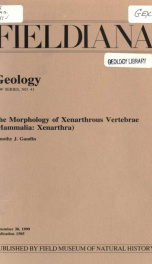The morphology of xenarthrous vertebrae (Mammalia: Xenarthra) Fieldiana, Geology, new series, no. 41

The presence of supplementary intervertebral articulations termed "xenarthrales" in the posterior dorsal vertebrae has been considered perhaps the most important diagnostic feature of the mammalian order Xenarthra. Xenarthrales are poorly understood, however, and substantial confusion exists in the literature over which facets are supplementary and which are not. Furthermore, much of the variation that exists in these joints, both within taxa and among the various xenarthran lineages, has gone unnoticed. Finally, the structural evolution of these facets has been inadequately treated. The goal of the present study is to describe the morphology of xenarthrous vertebrae in juvenile and adult extant xenarthrans and in extinct xenarthrans, to develop a model for the structural evolution of the supernumerary joints, and to use this information to assess the affinities of several enigmatic groups of early Cenozoic taxa (Palaeanodonta, Ernanodon, and Eurotamandua) with purported ties to the Xenarthra. Vertebral morphology is described in detail for two armadillo species, one species of anteater, and one extant and one extinct species of sloth, with brief comments on other xenarthran taxa. The results suggest that all xenarthrans are characterized by two sets of zygapophyseal facets in the post-diaphragmatic vertebrae, one medial and one lateral to the metapophysis. In addition, the Xenarthra is characterized primitively by a pair of xenarthrous facets on each side of the vertebra between the dorsal surface of the anapophysis and the ventral surface of the metapophysis of the succeeding vertebra. Other xenarthrous joints evolve within various xenarthran lineages. It is suggested that the supplementary facets developed initially in the diaphragmatic region of the vertebral column by means of a progressive widening of the zygapophyseal facets in the thoracic vertebrae and an increase in size of the metapophysis, which subdivided the zygapophyseal facets into medial and lateral facets. Hypertrophy of the anapophyses and their contact with the metapophyses led to the formation of true xenarthrous facets. -- A review of vertebral morphology in the Palaeanodonta, Ernanodon, and Eurotamandua revealed few resemblences to undoubted xenarthrans beyond hypertrophy of the metapophyses and anapophyses -- characteristics known to occur in many different groups of mammals. No supplementary intervertebral articulations could be documented unequivocally in any of these taxa. Thus, on the basis of vertebral morphology there is little evidence that would suggest a close phylogenetic relationship between true xenarthans and palaeanodonts, Ernanodon, or Eurotamandua Includes bibliographical references (p. 33-35) The presence of supplementary intervertebral articulations termed "xenarthrales" in the posterior dorsal vertebrae has been considered perhaps the most important diagnostic feature of the mammalian order Xenarthra. Xenarthrales are poorly understood, however, and substantial confusion exists in the literature over which facets are supplementary and which are not. Furthermore, much of the variation that exists in these joints, both within taxa and among the various xenarthran lineages, has gone unnoticed. Finally, the structural evolution of these facets has been inadequately treated. The goal of the present study is to describe the morphology of xenarthrous vertebrae in juvenile and adult extant xenarthrans and in extinct xenarthrans, to develop a model for the structural evolution of the supernumerary joints, and to use this information to assess the affinities of several enigmatic groups of early Cenozoic taxa (Palaeanodonta, Ernanodon, and Eurotamandua) with purported ties to the Xenarthra. Vertebral morphology is described in detail for two armadillo species, one species of anteater, and one extant and one extinct species of sloth, with brief comments on other xenarthran taxa. The results suggest that all xenarthrans are characterized by two sets of zygapophyseal facets in the post-diaphragmatic vertebrae, one medial and one lateral to the metapophysis. In addition, the Xenarthra is characterized primitively by a pair of xenarthrous facets on each side of the vertebra between the dorsal surface of the anapophysis and the ventral surface of the metapophysis of the succeeding vertebra. Other xenarthrous joints evolve within various xenarthran lineages. It is suggested that the supplementary facets developed initially in the diaphragmatic region of the vertebral column by means of a progressive widening of the zygapophyseal facets in the thoracic vertebrae and an increase in size of the metapophysis, which subdivided the zygapophyseal facets into medial and lateral facets. Hypertrophy of the anapophyses and their contact with the metapophyses led to the formation of true xenarthrous facets. -- A review of vertebral morphology in the Palaeanodonta, Ernanodon, and Eurotamandua revealed few resemblences to undoubted xenarthrans beyond hypertrophy of the metapophyses and anapophyses -- characteristics known to occur in many different groups of mammals. No supplementary intervertebral articulations could be documented unequivocally in any of these taxa. Thus, on the basis of vertebral morphology there is little evidence that would suggest a close phylogenetic relationship between true xenarthans and palaeanodonts, Ernanodon, or Eurotamandua Fieldiana series has been published as Geological Series by Field Columbian Museum (1895-1909) and Field Museum of Natural History (1909-1943), and as Fieldiana: Geology by Chicago Natural History Museum (1945-1966) and Field Museum of Natural History (1966-1978). Fieldiana Geology New Series No. 1 began June 29, 1979
Info about the book
Series:
Unknown
ISBN:
0521781175
Rating:
4/5 (4)Your rating:
0/5
Languge:
English
Users who have this book
Users who want this book
What readers are saying
What do you think? Write your own comment on this book!
write a commentif you like The morphology of xenarthrous vertebrae (Mammalia: Xenarthra) Fieldiana, Geology, new series, no. 41 try:
Other books by this author
Do you want to read a book that interests you? It’s EASY!
Create an account and send a request for reading to other users on the Webpage of the book!

